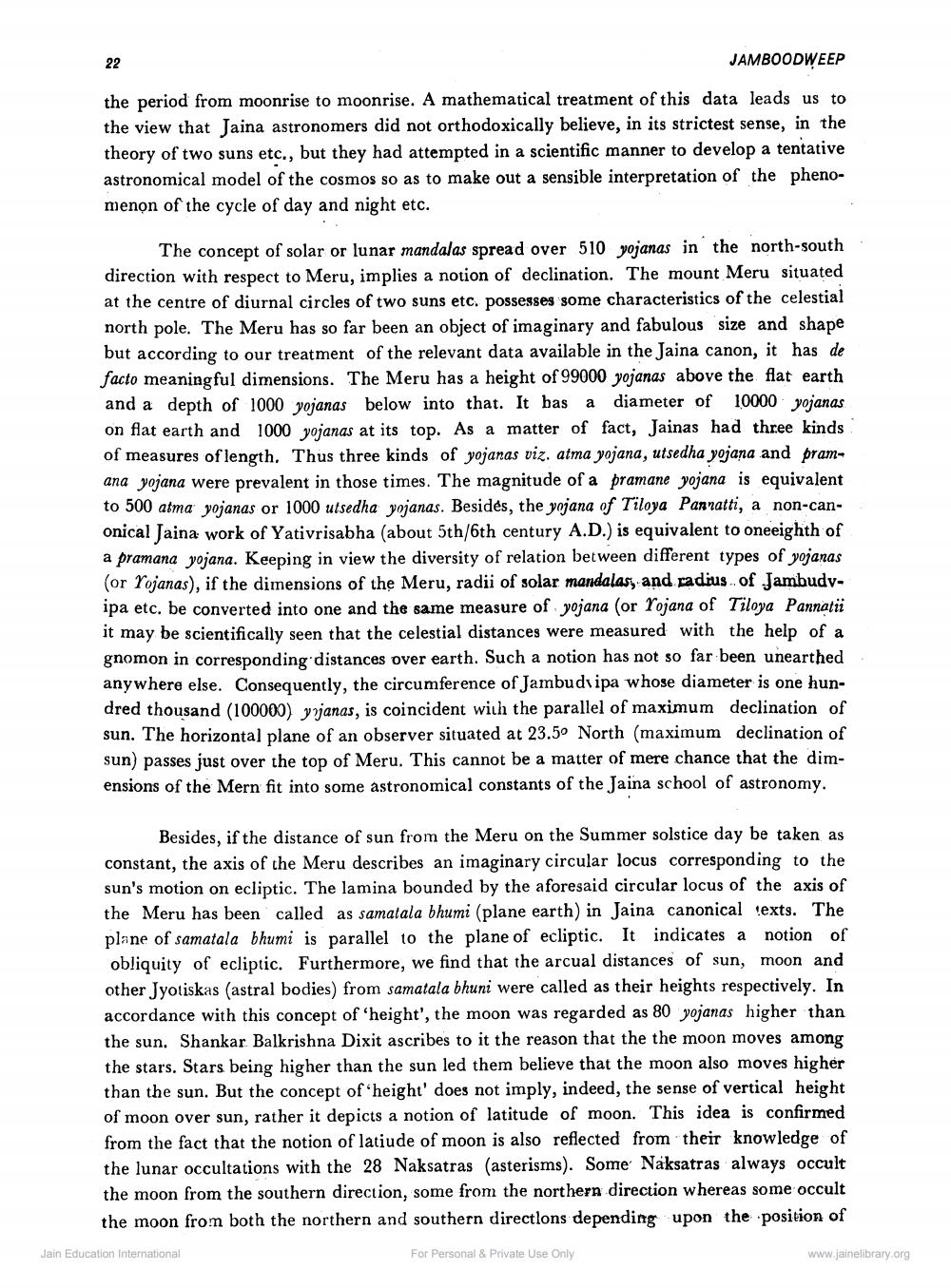________________
JAMBOODWEEP
the period from moonrise to moonrise. A mathematical treatment of this data leads us to the view that Jaina astronomers did not orthodoxically believe, in its strictest sense, in the theory of two suns etc., but they had attempted in a scientific manner to develop a tentative astronomical model of the cosmos so as to make out a sensible interpretation of the phenomenon of the cycle of day and night etc.
The concept of solar or lunar mandalas spread over 510 yojanas in the north-south direction with respect to Meru, implies a notion of declination. The mount Meru situated at the centre of diurnal circles of two suns etc. possesses some characteristics of the celestial north pole. The Meru has so far been an object of imaginary and fabulous size and shape but according to our treatment of the relevant data available in the Jaina canon, it has de facto meaningful dimensions. The Meru has a height of 99000 yojanas above the flat earth and a depth of 1000 yojanas below into that. It has a diameter of 10000 yojanas on flat earth and 1000 yojanas at its top. As a matter of fact, Jainas had three kinds of measures of length. Thus three kinds of yojanas viz. atma yojana, utsedha yojana and pramana yojana were prevalent in those times. The magnitude of a pramane yojana is equivalent to 500 atma yojanas or 1000 utsedha yojanas. Besides, the yojana of Tiloya Pannatti, a non-canonical Jaina work of Yativrisabha (about 5th/6th century A.D.) is equivalent to oneeighth of a pramana yojana. Keeping in view the diversity of relation between different types of yojanas (or Yojanas), if the dimensions of the Meru, radii of solar mandalas, and radius... of Jambudyipa etc. be converted into one and the same measure of yojana (or Yojana of Tiloya Pannatii it may be scientifically seen that the celestial distances were measured with the help of a gnomon in corresponding distances over earth. Such a notion has not so far been unearthed anywhere else. Consequently, the circumference of Jambud ipa whose diameter is one hundred thousand (100000) yrjanas, is coincident with the parallel of maximum declination of sun. The horizontal plane of an observer situated at 23.5° North (maximum declination of sun) passes just over the top of Meru. This cannot be a matter of mere chance that the dimensions of the Mern fit into some astronomical constants of the Jaina school of astronomy.
Besides, if the distance of sun from the Meru on the Summer solstice day be taken as constant, the axis of the Meru describes an imaginary circular locus corresponding to the sun's motion on ecliptic. The lamina bounded by the aforesaid circular locus of the axis of the Meru has been called as samatala bhumi (plane earth) in Jaina canonical texts. The plane of samatala bhumi is parallel to the plane of ecliptic. It indicates a notion of obliquity of ecliptic. Furthermore, we find that the arcual distances of sun, moon and other Jyotiskas (astral bodies) from samatala bhuni were called as their heights respectively. In accordance with this concept of 'height', the moon was regarded as 80 yojanas higher than the sun. Shankar Balkrishna Dixit ascribes to it the reason that the the moon moves among the stars. Stars being higher than the sun led them believe that the moon also moves higher than the sun. But the concept of height' does not imply, indeed, the sense of vertical height of moon over sun, rather it depicts a notion of latitude of moon. This idea is confirmed from the fact that the notion of latiude of moon is also reflected from their knowledge of the lunar occultations with the 28 Naksatras (asterisms). Some Naksatras always occult the moon from the southern direction, some from the northern direction whereas some occult the moon from both the northern and southern directlons depending upon the position of
Jain Education International
For Personal & Private Use Only
www.jainelibrary.org




